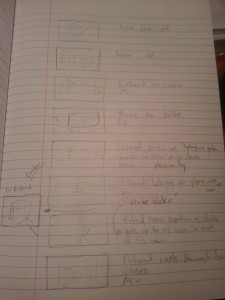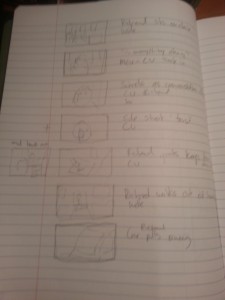Here are some rough pre production notes for my upcoming first real scene of my final project. I will attempt to expand and structure the notes in a friendly format, however I may leave some as dot points.
Scene Descriptor
The task as given by Robin:
Background:
Background: Richard lives in Melbourne
Long time girlfriend Sarah, lives in Geelong, it’s unfortunate.
they have a phone conversation one evening ending with a fight
One says, they might as well end their relationship – probably Richard
Sarah says – fine, I’m ringing Blake – Richards long time rival
Shoot a scene with Richard on the phone. When they hang up, Richard goes to his car to head off.
Constraints: can’t show Sarah, can’t show Richard driving
Character Notes
Richard:
In his early 20’s Richard has moved from Geelong to Melbourne to finish his final placement year of his teaching course.
Richard grew up with one brother and a single dad.
His father was good to him, but struggled with depression as a result from his mother leaving. This left Richard to take up part of that role in the care of his brother.
RIchard has been in a relationship with Sarah for 2 1/2 years, they met in college at Geelong.
They have flirted with the Idea of marriage but never considered it seriously.
Richard has a lot of spirit and loves his job working with kids.
His job has been taking up a lot of time recently and he has been unable to visit Sarah has often as he likes, this makes him guilty to an extent as he feels the onus is on him as he was the one that moved away.
He is an avid musician, often spending spare time writing, and playing.
Since moving to Melbourne Richard has been getting involved in lots of social circles. Meeting new people, has not taken away from his feelings for Sarah. Given the opportunity of his youthfulness however Richard is sometimes left with a slight feeling of not wanting to be trapped in a relationship.
Sarah:
Sarah lives in Geelong and is one or two years younger than Richard.
She still lives with her large, chaotic family – Richard enjoys being around her family given his upbringing.
She is still studying psychology in Geelong, sharing some units with Blake.
She is attractive but modest about it.
everything is going well for he, she knows that her life is a bit too perfect.
She secretly wants to experience some form of hardship so she can prove her own self worth
Sarah sees Richard being away as the first time she as experienced this ‘hardship’ – Richard seems to be handling it well
Sarah isn’t handling the distance as well as she thought she would and is feeling less confident in herself, like she is less courageous and feels that in a way she is failing the relationship.
Her grades have dropped slightly as a side effect, her identity is unstable.
Blake:
Blake is still at uni in Geelong with Sarah.
Used to be good friends with Richard, almost like brothers.
Blake and Richard grew up together in Geelong.
When they where kids Richard would always find ways to create excuses for the pairs’ mischief. In a way this thought Blake not to take responsibility for his own actions.
Blake, Sarah and Richard used to go to college together.
Blake met Sarah first, making a strong first impression he wanted Sarah before Richard.
The falling out – At some kind of pre drinks event Blake was talking up having some pseudo intellectual debate, Blake is antagonising Sarah as part of his act of picking her up. Richard spotting Sarah’s discomfort, steps in and in stops Blake, taking away his responsibility. Once Richard steps in Sarah is able to see through Blake’s facade.
Although Richard was not initially attracted to Sarah, the couple find common ground constantly agreeing with one another leaving blake out of place. Richard realises how self-centred Blake is or has slowly become.
Richard and Sarah hookup that night. Blake finds out the next day and interprets it as Richard taking a stab at him.
Richard and Blake stop talking Sarah continues to act as the middle ground.
Blake has learnt from his actions and maintains a friendship with Sarah,
Richard is always warning Sarah about Blake, and Richard now interprets any involvement Blake has with Sarah as an attempt to get back at him,
Recently Sarah has been meeting with Blake more often for uni, occasionally telling Richard on the phone.
Description of the conversation:
Starts as a routine conversation, Sarah calls Richard, small talk asksing about family etc.
She casually mentions Blake helped her with a uni project, pause, Richard questions her, holds back on his approach because he is uncertain.
Richard tries to change the subject, Sarah is aware and doesn’t give much of an answer, this annoys Richard.
Sarah secretly wants Richard to fight for her over Blake to reaffirm their relationship.
Richard asks if everything is okay – becomes a question of the state relationship
Richard bringing it up affirms to Sarah that there is a problem, Sarah brings up that she is going to finish a project, Richard questions if it’s the one with Blake, Sarah fumbles with her answer, Richard starts questioning more forcefully, Sarah is initially confused, then guilty, then becomes annoyed, argument ensues.
Sarah brings up trust – Richard is making it about Blake, in the heat of the moment she suggests they should take a break, Richard is taken aback, then question as to why it was even an option, Sarah panics is confused and says she has to leave, Richard asks if she is going to Blakes, She apologizes and says she has to go, hangs up.
Extra notes:
Sarah doesn’t want to say anything to fuel Richards jealousy, tension rises, Richard tries to settle but his tone gives his jealousy away
Duration reinforces tension on relationship as audience gets a sense that nothing is happening
Awkward pause, you can feel them mentally questioning the relationship, something has changed
I will add a few key scripted lines, and the story board once I get a chance to transfer them from my book.


